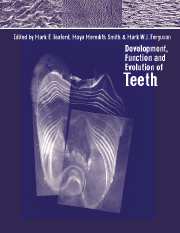Book contents
- Frontmatter
- Contents
- List of contributors
- Acknowledgements
- Part one Genes, molecules and tooth initiation
- Part two Tooth tissues: development and evolution
- Part three Evolution of tooth shape and dentition
- 10 Evolutionary origins of teeth and jaws: developmental models and phylogenetic patterns
- 11 Development and evolution of dentition patterns and their genetic basis
- 12 Evolution of tooth attachment in lower vertebrates to tetrapods
- 13 Tooth replacement patterns in non-mammalian vertebrates
- 14 The evolution of tooth shape and tooth function in primates
- 15 ‘Schultz's Rule’ and the evolution of tooth emergence and replacement patterns in primates and ungulates
- Part four Macrostructure and function
- Index
10 - Evolutionary origins of teeth and jaws: developmental models and phylogenetic patterns
Published online by Cambridge University Press: 11 September 2009
- Frontmatter
- Contents
- List of contributors
- Acknowledgements
- Part one Genes, molecules and tooth initiation
- Part two Tooth tissues: development and evolution
- Part three Evolution of tooth shape and dentition
- 10 Evolutionary origins of teeth and jaws: developmental models and phylogenetic patterns
- 11 Development and evolution of dentition patterns and their genetic basis
- 12 Evolution of tooth attachment in lower vertebrates to tetrapods
- 13 Tooth replacement patterns in non-mammalian vertebrates
- 14 The evolution of tooth shape and tooth function in primates
- 15 ‘Schultz's Rule’ and the evolution of tooth emergence and replacement patterns in primates and ungulates
- Part four Macrostructure and function
- Index
Summary
Introduction
The long-established scenario of teeth evolving from dermal denticles in direct association with the evolutionary origin of jaws, is based on the observation that shark (chondrichthyan) dermal denticles and oral denticles are homologous and contiguous with teeth. This theory, however, no longer accounts for the diversity of new data emerging from the fossil record. Certain denticle-covered fossil agnathan fishes (thelodonts) are now known to have well-developed oropharyngeal denticles. Moreover, the conodonts, a large and geologically extensive fossil group with a naked body but phosphatic mineralized feeding apparatus, are now thought to belong within the vertebrate clade. This projects the evolutionary origin of teeth, or at least a specialized suite of oral denticles, back to a point some 50 million years earlier than previously thought. These data suggest that ‘teeth’, in a broad sense of the term, may precede jaw evolution, and possibly precede the evolution of dermal armour in some primitive vertebrates. Alternatively, other new evidence shows that toothless armoured fish probably existed contemporaneously with conodonts. These include taxa with either dentine plus acellular bone-like basal tissue (Anatolepis, M. P. Smith et al., 1996), or acellular skeletal tissue, but no dentine (Young et al., 1996). Such discoveries challenge previously held views on the relative primitiveness of different tissues, and predict important stages in the evolution of signalling molecules for regulatory mechanisms during craniate mineralized skeletogenesis.
- Type
- Chapter
- Information
- Development, Function and Evolution of Teeth , pp. 133 - 151Publisher: Cambridge University PressPrint publication year: 2000
- 53
- Cited by



